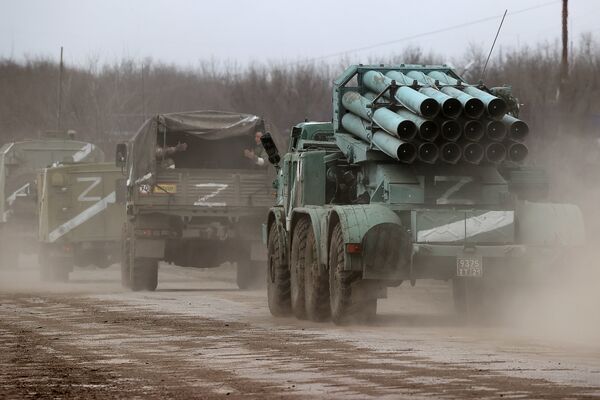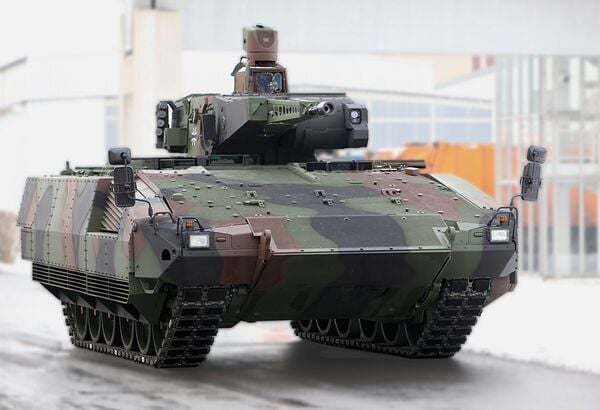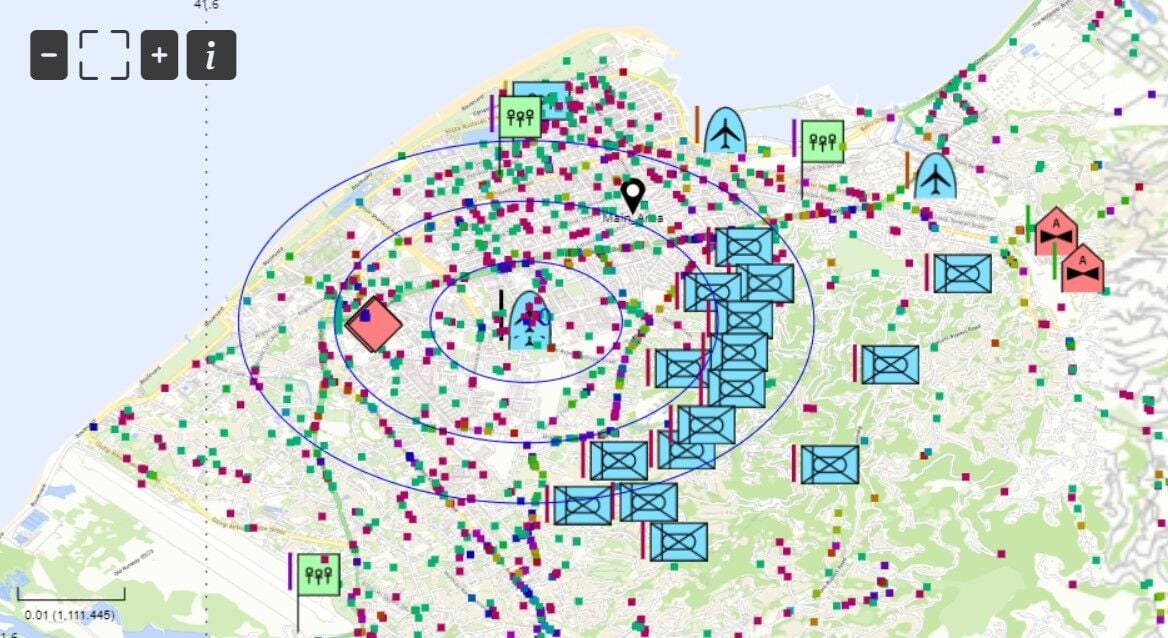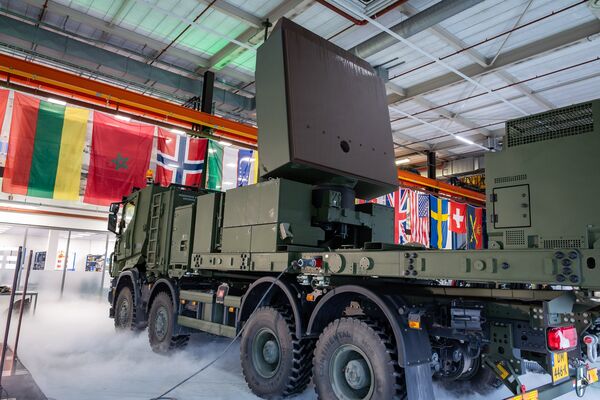- About
- Intara
- Capabilities
- Advisory
- Resources
- News
- Store
Ukraine conflict: Forces face recognition and tracking challenges
28 February 2022
by Huw Williams & James Rands


A column of Russian military vehicles leaves the town of Armyansk, northern Crimea, on 24 February. Spray-painted markings have been widely observed on vehicles. (Sergei Malgavko/TASS)
The Russian and Ukrainian militaries engaged in the conflict in Ukraine have several difficulties to overcome around force recognition and tracking, and the so-called ‘fog of war' may hang heavy.
Unverified reports state that the Russian Navy shot down a Russian aircraft over the Black Sea. Given the use of identification friend-or-foe (IFF) transponders, it should be a relatively straightforward task to avoid such incidents. In the land domain, differentiating between friend-or-foe is a significantly more demanding task.
Much of the materiel fielded by the belligerents is of the same type or has a common design lineage. Save for country-specific modifications and markings, it can be challenging to tell the equipment apart, especially at the ranges that engagements with modern weapon systems often take place.
Video footage and imagery emerging from Ukraine has shown attempts to simplify recognition, both on soldiers and vehicles, such as spray-painted markings on Russian vehicles and simple fluorescent armbands worn by Ukrainian forces.
In addition to these rudimentary efforts, however, discipline in following established tactics, techniques, and procedures (TTPs) may play a significant role in limiting incidents of fratricide. For example, armoured vehicles manoeuvring near the front lines are likely to keep barrels pointed in the direction of threat in order to signal their intentions. At the tactical level, units will have their own standard operating procedures for marking their positions, particularly of lead troops and the extreme flanks.
While there is no fool-proof means of differentiating a friend from a foe, the use of command-and-control (C2) systems that deliver force tracking, situational awareness, and other capabilities can bring significant benefits, both in limiting ‘friendly fire' incidents and enhancing combat effectiveness.
The extent to which C2 systems have been fielded with Ukrainian forces and their effectiveness cannot be ascertained yet. Forces have reportedly been equipped with an indigenous C2 capability that was developed by UA Defense. The Hermes-C2 system utilises a map-based display on a tablet computer with a touchscreen interface. It is intended to deliver situational awareness (SA)and features red and blue force tracking capabilities, a range of battle management tools – such as route planning and the ability to exchange sensor and other data – and chat communications.
The system has been observed in use during large-scale exercises in 2020, where it was integrated on armoured vehicles and networked with an unmanned aerial vehicle (UAV) and artillery elements. Target co-ordinates were passed from the UAV to the Hermes-C2 system and onwards to the artillery fire-control system, where the ballistic calculations were made.
At the tactical level, a number of C2 systems have been developed for the Russian military. The Strelets system forms part of the wider Ratnik soldier system. Two versions of the system have been identified: one for use by commanders that features a digital map interface on a touchscreen personal digital assistant (PDA), which displays force tracking data among other information; the other is intended for infantry personnel with a digital compass instead of the map. The C2 functions include tactical chat and the ability to network with different levels of command and other components, sharing a range of data, such as targeting information and imagery. It is unclear how widely systems have been fielded under the Ratnik programme.
The UNKV-E system has also been developed for dismounted applications, with three devices – individual soldier, platoon commander, and company commander – linked by VHF and wireless communications, all have GPS/GLONASS. The individual soldier version is a handheld device that is limited to text and voice communications. The platoon commander device is also handheld with a small screen for situational awareness, while the company commander has a ruggedised tablet.
Also at the tactical level, the ASUV TZ command system is intended for use from the platoon level upwards. It includes a digital mapping system that can display the tactical picture and a range of battle management functions. In its armoured fighting vehicle configuration, the ASUV TZ has been identified as fitted on BTR-80 and -90, BMP-2 and -3, and MT-LBU vehicles.
The C2 systems in service in Ukraine will be operating in demanding conditions. Ukraine and Russia are known to be equipped with advanced electronic warfare (EW) systems that can jam GPS and both radio frequency (RF) and satellite communications, which are essential for C2 systems to operate effectively. Through these jamming systems, both militaries can potentially create a so-called C2 denied or degraded environment (C2D2E). Furthermore, any fighting in built-up areas can significantly impact the efficacy of C2 systems, especially when operating with older radios or relying on satellite communications alone.
While robustness can be built into systems to ensure that they offer the most basic force tracking and other C2 functions in difficult conditions – such as through smart management of bandwidth and using high frequency (HF) communications, which offers more resilience against jamming – it is likely that much of the C2 on the ground will be achieved via voice communications. Whether that be via radio, satcom, or cellular phone, indeed for as long as cellular networks are available the latter may prove to offer an effective – if rudimentary – form of force tracking and text ‘chat' through built-in commercial features and apps.
Germany orders simulators for Puma IFVs
19 April 2024
by Olivia Savage


The Bundeswehr has ordered 258 sets of AGDUS systems for its Puma IFVs following successful integration tests. (PSM GmbH)
The Bundeswehr is receiving new training simulators for its Puma infantry fighting vehicles (IFVs).
In total, 258 sets of Training Device, Duel Simulator (Ausbildungsgerät Duellsimulator: AGDUS) systems are being delivered for the Puma IFVs by the end of 2026, the Bundeswehr announced on 15 April.
The EUR109 million (USD116 million) contract will be financed from the EUR100 billion Bundeswehr special fund.
A Rheinmetall/Krauss-Maffei Wegmann (KMW) consortium received an order from the Bundeswehr in December 2019 valued at EUR54 million for the provision of six AGDUS systems for integration tests on the Puma. Full-scale serial production of AGDUS would then begin once testing was complete, with up to 252 Puma IFVs being equipped with the systems for EUR88 million.
A Rheinmetall spokesperson confirmed to Janes that the company, along with KMW+Nexter Defense Systems (KNDS) Germany, are supplying the new AGDUS simulators to the Bundeswehr and that full-scale production has now officially begun.
Hadean, 4C Strategies integrate products to reduce training burden
18 April 2024
by Giles Ebbutt


A screenshot of the Hadean POLI constructive simulation displayed through the 4C Strategies Exonaut training management software. (Hadean)
Hadean and 4C Strategies have successfully integrated a constructive simulation with Exonaut exercise management software, utilising Hadean's spatial computing platform.
The integrated solution, displayed at the International Training Technology Exhibition & Conference (IT²EC) 2024 in London, enabled Hadean's Pattern of Life Indicator (POLI) constructive simulation to be controlled from within 4C Strategies Exonaut software.
Exonaut is widely used in the UK and NATO as an exercise management tool, while constructive simulation is fundamental to effective command and staff training. Integrating the two previously separate functions offers the potential to improve training.
Explaining the integration, Paul Steel, UK military sales director for 4C Strategies, told Janes
Thales to supply Netherlands with seven additional radars
16 April 2024
by Olivia Savage


The Netherlands has ordered seven additional GM200 MM/C radars from Thales after having ordered an initial nine in February 2019. Pictured is the first GM200 MM/C radar being handed over to the Royal Netherlands Army in Hengelo in February 2024. (Dutch MoD/Sgt Maj Gregory Fréni)
The Dutch Command Materiel and IT (COMMIT) procurement authority has ordered seven additional Ground Master 200 Multi-Mission/Compact (GM200 MM/C) radars from Thales.
The contract includes an option for two additional radars, according to a Thales announcement on 15 April.
The GM200 MM/C is a compact mobile radar that can detect, track, and classify a large number of targets including rockets, artillery shells, mortar rounds, unmanned aerial vehicles (UAVs), aircraft, helicopters, and cruise missiles.
For the Royal Netherlands Army (RNLA), the radars will be mounted on Scania Gryphus 8×8 trucks to enable rapid deployment.
A Thales spokesperson was unable to comment to Janes on the delivery timeframes.
This latest contract follows an initial agreement in February 2019 for nine GM200 MM/C radars for EUR100–250 million (USD106–266 million) to replace its legacy TPQ-36 radars. Deliveries are expected to be completed by 2024. In February Janes
The Russian and Ukrainian militaries engaged in the conflict in Ukraine have several difficulties to...
Latest Podcasts
Iran Israel analysis
In this podcast Janes analysts discuss the Iranian attacks on Israel on the 14 April. They highlight the military systems used by Iran and the performance and impact of these on Israel. They also discuss the implications of this attack goi...
Listen nowJanes Case Studies
Using Janes Intara to build a common intelligence picture: Russian build up on the Ukrainian border
View Case StudyNews Categories
 Defence Details
Defence Details